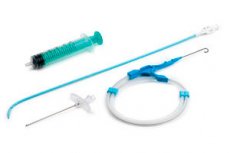Medical expert of the article
New publications
Pericardial drainage
Last reviewed: 29.06.2025

All iLive content is medically reviewed or fact checked to ensure as much factual accuracy as possible.
We have strict sourcing guidelines and only link to reputable media sites, academic research institutions and, whenever possible, medically peer reviewed studies. Note that the numbers in parentheses ([1], [2], etc.) are clickable links to these studies.
If you feel that any of our content is inaccurate, out-of-date, or otherwise questionable, please select it and press Ctrl + Enter.

Pericardial drainage refers to a surgical technique, the essence of which is to remove fluid contents from the pericardial cavity. In the process of pericardial drainage, the doctor makes an incision, cuts the pericardial cavity itself and removes its contents. During the operation, a drain is often installed, through which the outflow of fluid from the pericardial cavity is carried out.
The operation is performed in an inpatient setting. It does not belong to the number of complex operations. However, any surgical intervention in the heart cavity is already a serious enough procedure. Accordingly, the patient needs rehabilitation, appropriate care and supervision by specialists.
Often the need for drainage occurs in the postoperative period, in traumatic injury of the heart, other adjacent organs. Ruptures and trauma of the abdominal and thoracic cavities are often accompanied by trauma to the pericardium, due to which there is an accumulation of fluid in its cavity. In such situations, urgent drainage is required, aimed at eliminating the pathological contents. Often the pericardium is damaged in major accidents, disasters, in emergency situations of natural or man-made nature. In such cases, the operation is carried out directly at the scene of the accident, or in the car reanimobile, ambulance. In this case, the manipulation should be performed by an experienced specialist who knows not only the peculiarities of manipulation, but also ways to overcome possible obstacles.
Drainage of the pericardial cavity is carried out in case of injuries that are accompanied by severe blood loss, blood effusion into the pericardial cavity. The procedure requires an operating room, sterile conditions. Therefore, the patient is hospitalized in a planned or emergency procedure. Outpatient procedure can be performed if hemotamponade develops, and also if it is not possible to hospitalize the patient in the hospital. The procedure is performed by a cardiac surgeon.
The technique of performing the procedure is relatively simple. Thus, the patient lies in the supine position with a roll under the lumbar region. In emergency cases, the patient can be in a sitting position, but the head should be tilted. An important role is given to compliance with the rules of asepsis and antisepsis. Therefore, before making a puncture, the skin is treated with antiseptic agents. Most often ethanol, iodine is used. But other, complex antiseptic agents can also be used. For the puncture, a thin needle is used, a syringe with a volume of 20 ml. To ensure local anesthesia, an anesthetic agent is injected into the heart cavity. Most often novocaine, lidocaine is used.
Separately, it is worth considering the technique of the procedure. Thus, to ensure drainage of the pericardial cavity, a puncture is made slightly above the mesoid process. Along the puncture line, the needle is directed upward, in an oblique direction. The puncture should be made to a depth of approximately 3 cm. The fact that the needle has entered the heart cavity is indicated by the flow of fluid into the syringe. If the puncture is done correctly, blood or fluid accumulated in the heart cavity begins to flow into the syringe. The patient immediately feels better: this indicates that the manipulation was performed correctly. The patient's condition improves markedly. In the first minutes after drainage of the pericardial cavity there is normalization of the heart tone, blood pressure decreases, pulse rate, heart rhythm, HR are restored. Subjective sensations - the patient becomes easier to breathe, stops "fluttering" heart. Normally, there is always a small amount of fluid in the cavity, but it should be used exclusively for lubrication of the walls, protection from mechanical damage. Excess leads to the development of pathological processes. Therefore, after draining the pericardial cavity, a small amount of fluid should normally remain, which will ensure normal heart function.
The procedure is performed for therapeutic purposes only, if indicated. The procedure is not performed for prophylactic purposes. The main indication for pericardial drainage is fluid accumulation in the pericardial cavity. Fluid can accumulate in the heart cavity with traumatic and inflammatory damage to the pericardium, with rheumatic lesions of the heart, with many oncologic diseases, and even with the development of cysts, benign neoplasms. The procedure is indicated in cardiac and respiratory insufficiency, after severe surgical manipulations, in such severe conditions as compression of the heart and adjacent organs, cardiac tamponade and hemithamponade. Any accumulation of fluid is an indication for drainage of the pericardial cavity, whether purulent, serous, or hemorrhagic exudate. In acute cardiac tamponade, pericardial drainage is a temporary measure to buy time until a full operation.
It should be borne in mind that even drainage of the heart cavity can be contraindicated under certain circumstances. Thus, the procedure can not be performed in such conditions as blood clotting disorders, thrombocytopenia, hemophilia. Contraindicated procedure when taking anticoagulants, blood thinners, treatment with analgin. It is also not worthwhile to carry out the procedure if the content of the pericardial cavity is small. This is due to the fact that it is impossible to completely eliminate fluid from the heart, since it performs an important role in ensuring its normal functioning.

